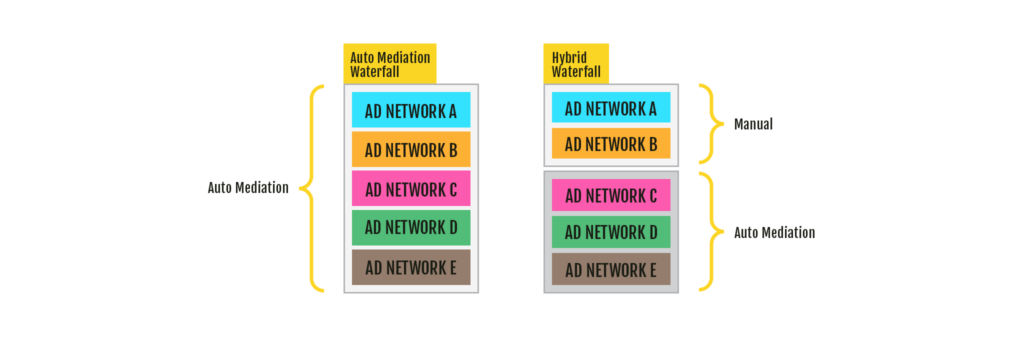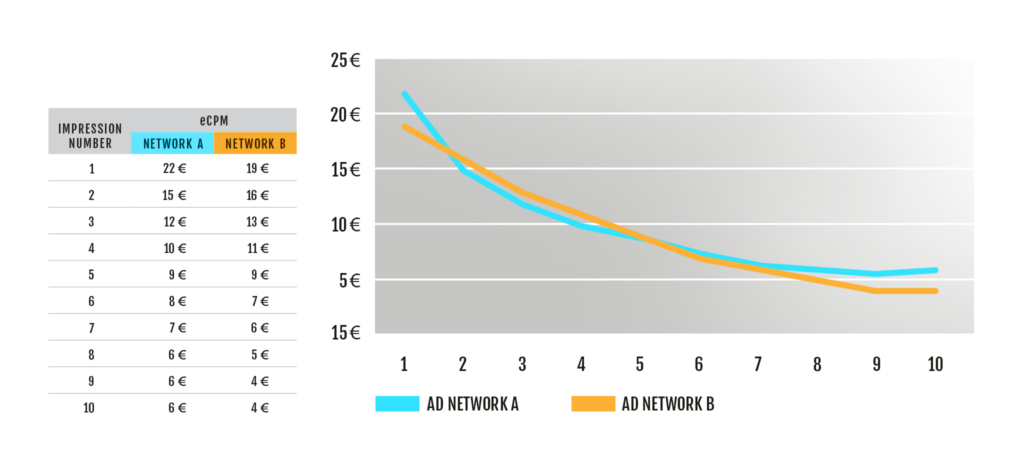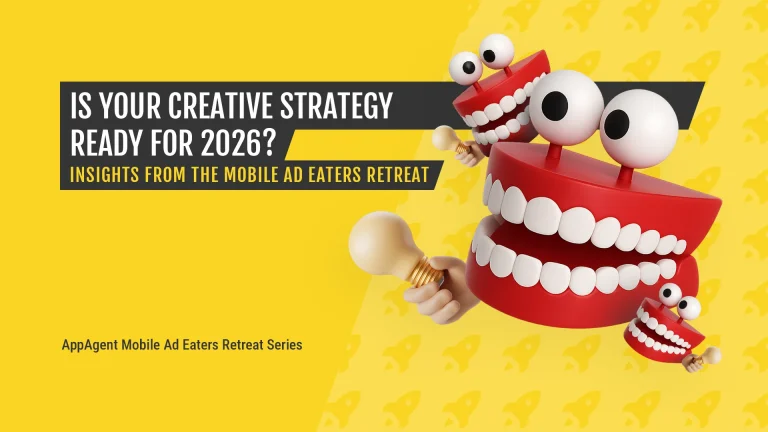To learn more about industry insights and best practices, sign up for the AppAgent newsletter here.
Ad monetization waterfalls might sound confusing, but the principle behind them is reassuringly simple. In this in-depth article, we look at what ad monetization waterfalls are and why setting eCPM floors is an essential part of maximizing your return. A little bit of work can ensure your app is maximizing its potential for profit.
This is a guest blog post by Jacopo Guanziroli who provides consultancy for AppAgent on ad monetization topics. Jacopo worked at Barcelona-based Social Point as Ad Monetization Manager. Alongside AppAgent he works with Flaregames and Gamehouse and regularly publishes on his blog Digital Limbo.
What Is an Ad Monetization Waterfall?
In mobile advertising, a monetization waterfall is a hierarchy of ad networks, ranked based on criteria like eCPM (effective cost per thousand impressions), fill rate, and latency. When a user triggers an ad request, the mediation platform “cascades” through the list — starting with the network offering the highest expected payout — until it finds one with available inventory.
Think of it as a priority queue to make sure each user sees the most valuable ad possible.
How Waterfalls Work (and Where Mediation Comes In)
Ad monetization waterfalls are an effective way to maximize revenue through your app. The simplest way is to integrate a mediation layer, plug in some ad networks within it, and leave the responsibility of waterfall management to the all-powerful algorithm.
The waterfall we’re talking about here is the order in which the integrated networks are initiated. The waterfall ranks each network by their performance on key metrics, including eCPM, fill rate, latency and others. By using a waterfall, you can be confident that a user sees an advert – and you see a return.
This diagram clearly describes the ad requests and the fill/flow process.
The mediation layer here is in charge of delivering the order. Within this auto-mediation process, the system decides which ad to show the user.

Manual vs. Hybrid Waterfalls: How Much Control Do You Want?
Typically, the mediation algorithm displays adverts from the ad network that has returned the best eCPM. It makes sense, but you can override it. If you want, you can ignore the algorithm and apply a manual order. Here, the ad manager has control for the ranking of video providers, and therefore the order in which ads are displayed.
You can choose from an entirely automated model, a completely manual one and a hybrid version – where you can specify both manual ordering and automated ordering.

In practice, a hybrid order looks like this:
- Ad Network A receives all requests from your app regardless of eCPM. Requests keep coming until they have no more campaigns to show.
- Once Ad Network A has been exhausted, the app starts displaying ads from Network B, until they run out too.
- At this stage, the algorithm kicks back in and starts to work again, displaying ads according to the eCPM.
So, is this the perfect solution? Sadly not.
The reason is that the eCPM isn’t the same for each impression served by the same ad network. The more ads that are requested, the lower the eCPM gets.
To achieve the best results – and achieve the best return – you need to introduce eCPM floors.
Hit the floor
Before we look at eCPM floors, it’s important to understand just why the eCPM decreases as an individual user watches more and more video ads.
Over time, the higher the number of impressions served by the same network, the lower the eCPM. This happens because the more videos the same user sees, the less likely he or she is to click an advert, and the less likely they are actually to install the app.
App advertisers set their campaign bids to appear before other advertisers, increasing the conversion rate of their campaigns. It’s easier to describe using an example.
Let’s say the average eCPM delivered by Network A is 10€, and Network B 9€. Naturally, we show ads from Network A because they’re paying more.
But look closer:
-
Network B’s first impression has an eCPM of 11€.
-
Network A’s second impression might drop to 9€.
If we always favor Network A based on its average, we leave money on the table.
App advertisers set their campaign bids to appear before other advertisers, increasing the conversion rate of their campaigns.
It’s easier to describe using an example. Let’s say the average eCPM delivered by Network A is 10€, and Network B 9€. Naturally, we’ll show ads from Network A because they’re paying more.
But if we leave the average on the side for a moment and we look in detail the eCPM evolution per impression for each network, we’ll notice that the first impression of Network B has an eCPM that’s higher than the second of network A.

If we manually dictate that all ads from Network B, we will lose revenue. It’s a sub-optimal strategy. This situation is where eCPM floors are needed.
Setting an eCPM floor is a rule that instructs your network not to serve ads below your pre-defined threshold. It’s easier to describe using these diagrams.
We need to create two separate calls for Network A. The first demands a minimum eCPM of 20€ and the other a minimum 15€.

We can do the same for Network B (but the values are different).

Now comes the exciting part. Armed with this new bit of information we can stop using a simple top-rank setup, and instead create a new waterfall based on eCPM floors.
Here’s how that looks in practice.

You can see that by using eCPM waterfalls, we’re able to drive the maximum return from our adverts.
Setting this up isn’t easy, but it is crucial. You must follow this process for every app, on every platform and in every country (at least the relevant ones in terms of DAUs).
It’s essential that to configure the different floors (which can also be called calls, zones or instances) on a mediation platform effectively, they first must be created on the ad network dashboards.
Don’t forget to integrate the ad revenue in your LTV model as this can substantially change your business economics and campaign ROI evaluation. More on how to calculate LTV can be found in the talk by Martin Jelinek or his Executive Summary on LTV predictions modeling published with Appsflyer.
Best Practices for Setting eCPM Floors
-
Use historical eCPM data per country and platform to set dynamic floors
-
Create multiple floor tiers per network (20€, 15€, 10€, fallback)
-
Adjust floors weekly based on fill rates and RPM
-
Test rewarded vs interstitial ad units separately
-
Integrate ad-level revenue into your LTV and ROI calculations
Don’t Forget to Factor Ad Revenue into LTV
Don’t forget to integrate the ad revenue in your LTV model as this can substantially change your business economics and campaign ROI evaluation. More on how to calculate LTV can be found in the talk by Martin Jelinek or his Executive Summary on LTV predictions modeling published with Appsflyer.
Final Thoughts
Waterfalls and floors are often treated as “set it and forget it.” But when optimized carefully, they offer substantial revenue uplift — especially in markets or apps where ad engagement is high.
And while in-app bidding is growing, waterfall management is still essential for:
-
Filling gaps in bidding coverage
-
Maximizing first-impression value
-
Controlling monetization per GEO/platform
For mature apps or scale-focused studios, combining LTV modeling, smart floors, and hybrid waterfall logic can lead to meaningful improvements in both revenue and UA efficiency.









